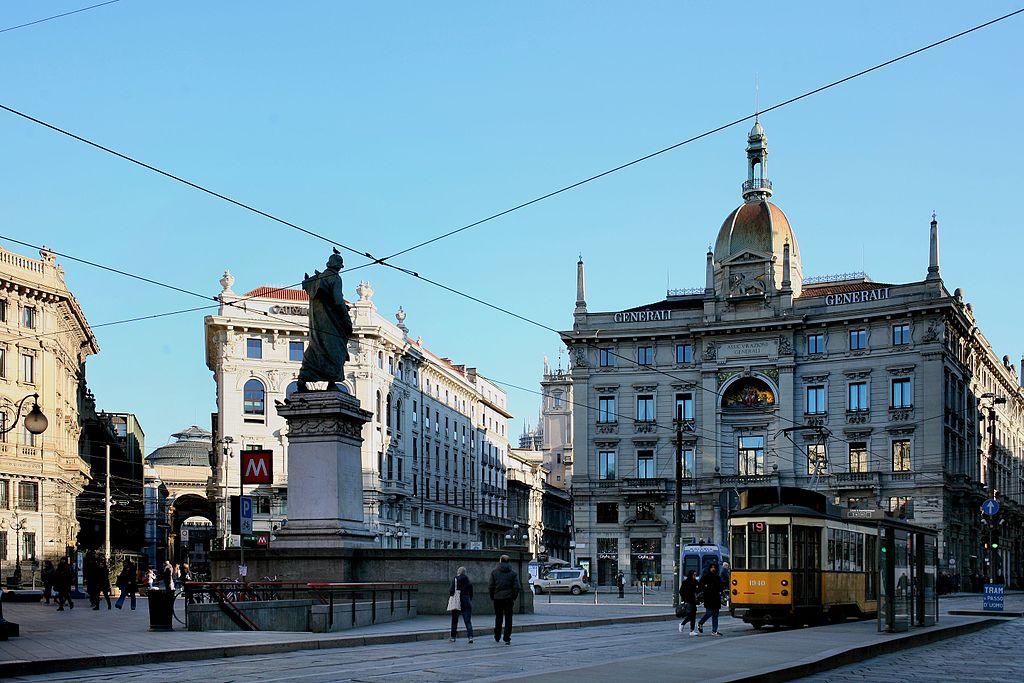Piazza Cordusio


Piazza Cordusio è una piazza di Milano posta dove sorgeva la corte dei duchi longobardi, la Curia Ducis, da cui deriva il nome della piazza.
Un tempo rappresentava il centro finanziario di Milano, dal momento che ospitava le sedi di varie istituzioni finanziarie.
Curiosità
Il nome Cordusio segue appunto un complesso senso logico.
Il re dei Longobardi, Alboino, scese in Italia nel 568.
Da allora l'area divenne Langobardia, e in seguito Lombardia.
Morto Alboino nel 572, la Provincia venne divisa fra i tre generali (che divennero duchi).
Un palazzo, che sorgeva nell'odierna piazza, era detto "De curte ducis" (o "Curia ducis", ossia la corte dei duchi lombardi), da cui per contrazione "Cortedoxi", quindi "Corduce" e infine "Corduso" o "Cordusio".
Prima di diventare piazza Cordusio, la conformazione era quella di una strada, poi diventata uno slargo chiamato largo Cordusio. Lo slargo aveva forma ellittica e nel 1882 fu chiamata piazza Ellittica (e talvolta erroneamente Elittica). Tuttavia i milanesi continuavano a chiamarla piazza Cordusio e il Comune si convinse a restituirle l'antica denominazione. Successivamente il nome subì un cambiamento anche sotto il fascismo e la piazza fu intitolata a Costanzo Ciano, per poi tornare ad essere Cordusio dopo la caduta del regime.
All'interno della piazza era inizialmente stata eretta una delle tante colonne votive di Milano, costruite durante la peste del 1576. Successivamente, nel 1624, venne eretta una statua raffigurante San Carlo Borromeo, spostata nel 1786 nella piazza nei pressi della Chiesa di Santa Maria Podone.
Si dice che la decisione fosse stata presa dal Governatore austriaco di allora, giustificandola come di "intralcio alla circolazione", dopo che andò a sbattervi contro con la carrozza
Nel 1899 al centro della piazza viene inaugurata la statua a Giuseppe Parini, opera di Luca Beltrami dove troverete la cache.

Piazza Cordusio is a square in Milan located where the court of the Lombard dukes stood, the Curia Ducis, from which the name of the square derives.
At one time it represented the financial center of Milan, since it housed the headquarters of various financial institutions.
Curiosity
The name Cordusio precisely follows a complex logical sense.
The king of the Lombards, Alboino, descended to Italy in 568.
Since then the area became Langobardia, and later Lombardy.
Died Alboino in 572, the Province was divided between the three generals (who became dukes).
A palace, which stood in today's square, was called "De curte ducis" (or "Curia ducis", that is the court of the Lombard dukes), from which by contraction "Cortedoxi", then "Corduce" and finally "Corduso" or "Cordusio".
Before becoming Piazza Cordusio, the conformation was that of a road, which later became a widening called Largo Cordusio. The widening had an elliptical shape and in 1882 it was called Piazza Ellittica (and sometimes erroneously Elliptical). However, the Milanese continued to call it Piazza Cordusio and the Municipality was convinced to return the ancient name. Subsequently the name underwent a change also under Fascism and the square was named after Costanzo Ciano, to then return to being Cordusio after the fall of the regime.
Inside the square, one of the many votive columns of Milan had been erected, built during the plague of 1576. Subsequently, in 1624, a statue representing San Carlo Borromeo was erected, moved in 1786 to the square near the Church of Santa Maria Podone.
The decision was said to have been made by the then Austrian Governor, justifying it as a "hindrance to traffic", after he bumped into you with the carriage
In 1899, the statue of Giuseppe Parini, by Luca Beltrami where the cache is found, is inaugurated in the center of the square.